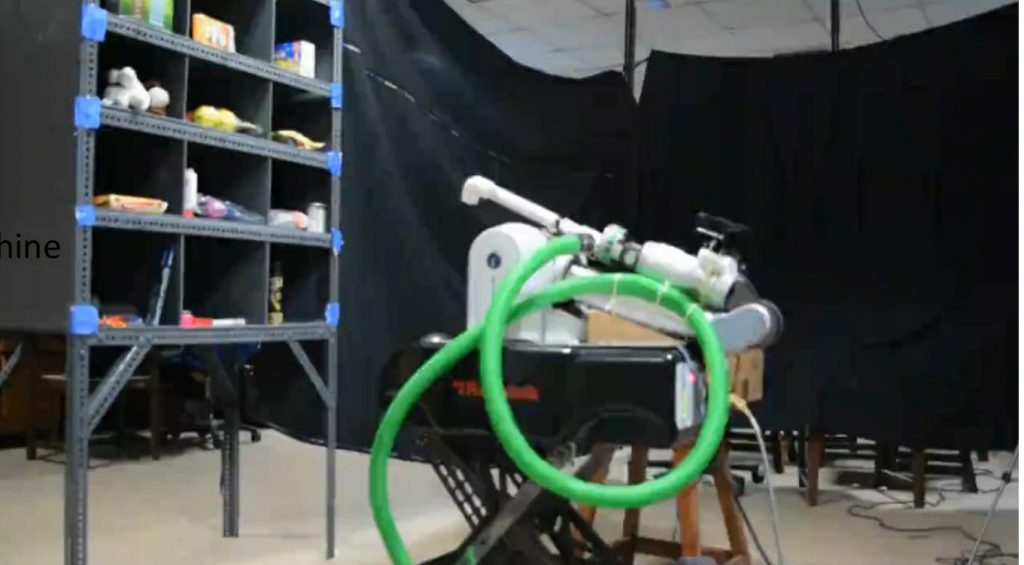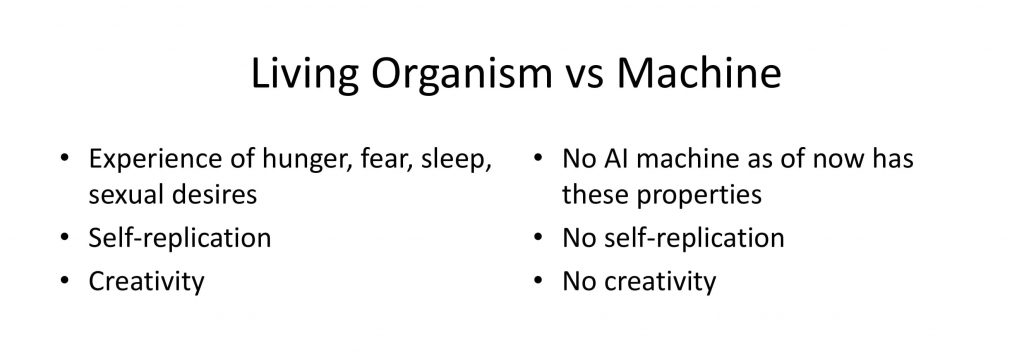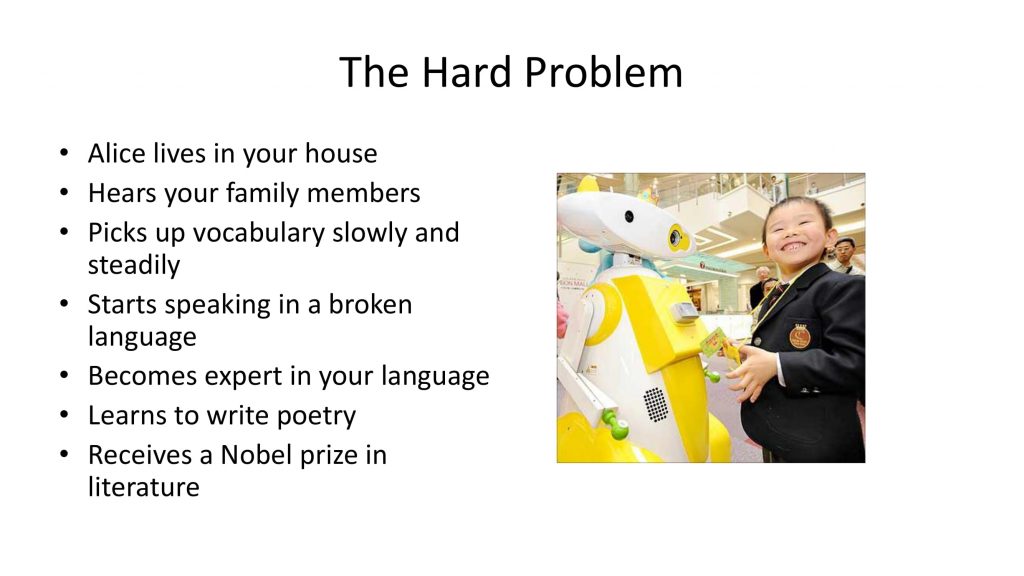Can we build a conscious machine – There is a buzzing among AI researchers in regard to building a conscious machine. But do we understand what consciousness is? In Bhagavad Gita, Lord Krishna talks about consciousness as that which is immutable, immovable, indestructible, un-burnt, un-cut, un-wet and always existing (eternal) – the qualities that are not observable in physical realm. When situated in consciousness, one becomes free from ignorance– always situated in knowledge and transcendental joy. Moreover consciousness cannot be created and destroyed. This is an experience that is beyond our current experience of mundane space and time. What kind of conscious machine can we build then?
Table of Contents
An Example from History
We have heard about Bhagavata Sankhya – a scientific explanation of basic building blocks of this creation as taught by Lord Kapila to his mother Devahuti. Devahuti the famous daughter of Swayambhuva Manu married to Kardama who has also achieved mystic perfection by virtue of his strong practice of devotional service at the lotus feet of Lord Krishna. He was served sincerely by his wife in his daily performance of fire sacrifices and other vedic rituals. Seeking to please his beloved wife, the sage Kardama exercised his yogic power and instantly produced an aerial mansion that could travel at his will. It was a wonderful structure, bedecked with all sorts of jewels, adorned with pillars of precious stones, and capable of yielding whatever one desired. It was equipped with every form of furniture and wealth, which gradually increased in the course of time.

Among other descriptions of this aerial mansion, here is one that will surely catch our attention:
Here and there in that palace were multitudes of live swans and pigeons, as well as artificial swans and pigeons so life like that the real swans rose above them again and again, thinking them live birds like themselves. Thus the palace vibrated with the sounds of these birds.
Obviously these artificial swans are examples of conscious machines that we are trying to build. But the consciousness in such machines certainly does not refer to the absolute consciousness that Lord Krishna talks of in Bhagavad Gita. Let’s consider the naïve consciousness. Conscious we are, as we are aware of our body, mind and identities. We need to distinguish between a living body and dead body. Let’s revisit the following two verses from Bhagavad Gita in Chapter 13 Verse 6-7:
mahā-bhūtāny ahaṅkāro
buddhir avyaktam eva ca
indriyāṇi daśaikaṁ ca
pañca cendriya-gocarāḥicchā
dveṣaḥ sukhaṁ duḥkhaṁ
saṅghātaś cetanā dhṛtiḥ
etat kṣetraṁ samāsena
sa-vikāram udāhṛtam
Translation: The five great elements, false ego, intelligence, the unmanifested, the ten senses and the mind, the five sense objects, desire, hatred, happiness, distress, the aggregate, the life symptoms, and convictions – all these are considered, in summary, to be the field of activities and its interactions.
Here it is very clear that even living symptoms and convictions are not the part of pure consciousness. In scientific community, a distinction between a machine and a human collapses if behaviorally there is no distinction between the two.
For example please look at the set up in my lab:

A robot is given a list of objects to pick from a rack. Using a mounting camera, the robot sees every box of rack, locates the desired object and picks. It is like you go to a shop and give the shopkeeper a list of items you need. The shopkeeper looks at various racks and picks the desired item. In this case both the robot and the human being are behaviourally identical in terms of picking objects but are they same? A human can claim that he is self-aware, but the machine cannot claim so. Human consciousness is subject to hunger, fear, sleep and sexual urges while a machine is inert in this regard. Creativity and self-replication are norms in humans while current machines empowered by advanced AI tools are simply procedural and computationally driven.

Lets consider a thought experiment. The robot Alice lives in your house and hears your family members. She picks up vocabulary slowly and steadily, and starts speaking in a broken language. In due course of time, she becomes expert in your language and learns to write poetry. Her creative writing makes her to receive a Nobel prize in literature.

A deep introspection on this thought experiment will let us know about the challenges to build such conscious machines that are self-aware, have self-identity and are creative. How can a machine be naturally creative? I will argue based on Bhagavata Sankhya given in Srimad Bhagavatam in 3rd Canto that we need to evolve the idea of semantic space.
Semantic Space –The Basic Building Block of this Universe
We all exist in some space. The solar system is operating in some space. Various information such as sound, touch, form, taste and smell exist in different spaces. What is the space?
A simple definition is as follow: Space is that which gives distinct identity to every object. Let’s do a thought experiment. Let’s close our eyes and imagine that all forms of space are withdrawn. As space is being withdrawn, we will experience that all distinctions among different life forms are collapsing, my body has collapsed, my house is no more, my city is no more, my country is no more, the world is no more, the solar system is no more, and the universe is no more. As we continue our thought process, the language will collapse as words will cease to exist. Our thought content which is dependent on the existence of this material space will also cease to exist. Our notion of I and mine (false consciousness) will finally cease to exist. As we continue our thought process – we enter into complete darkness where we may have a faint experience of our own existence. In that existence, I feel like drowning in the ocean of ignorance. Who am I? Where am I? What is my locus?
In Bhagavad Gita we learn about eight different categories of semantic spaces that constitute this phenomenal space – the world of experience.

Earth is the space of smell, water is the space of taste, fire is the space of form, air is the space of touch and ether is the space of sound. Similarly the mind is the space of emotions and desires. Intelligence is the space of concepts and abstractions. The last element is false ego which is the space of false identities. The mutual interactions among these eight spaces create my identity and my world. But all these manifestations are illusory as the spirit self is beyond this illusory experience. What is the connection of the spirit self with the illusory self? How does an object from divine (conscious) space interact with the illusory self that is made of material space?
When I pinch you at your specific part of your body, you feel the pain at that very spot? You do not feel that pain in your brain. Why?
Krishna says in BG 2.17:
avināśi tu tad viddhi
yena sarvam idaṁ tatam
vināśam avyayasyāsya
na kaścit kartum arhati
Translation: That which pervades the entire body you should know to be indestructible. No one is able to destroy that imperishable soul.
However this indestructible consciousness is not subject to pain. Why do you then experience pain? This is a great mystery that can be unravelled if we attempt to build a conscious machine. Every activity we do in this world must be firmly directed towards understanding the self.
I am conscious of my body because from time immemorial I am associating with that which I am NOT. This gives rise to my false identification. At the level of false ego, material space and conscious space are highly subjective although false consciousness is mere shadow of the pure consciousness. This false consciousness is born out of modes of material nature. This is created according to my conditioned state. According to Vedic literature I am made to wear many artificially conscious dresses among 8.4 million species. These dresses are created and hence these bodily consciousness are subjected to birth and death. Can we create such illusory dress?
A person who is capable of distinguishing pure self and illusory self can only build such a machine. Mostly soul is dormant – it is not wakeful. Although human, we mostly behave like a robot. When by proper divine practice, the soul is awakened; he sees both conscious and illusory space. The normal practice of divinity in this age is to chant the holy name of the Lord:
Hare Krishna Hare Krishna Krishna Krishna Hare Hare
Hare Rama Hare Rama Rama Rama Hare Hare
Current machines are mostly developed in mode of ignorance and have caused great harm to the natural environment. The proposed conscious machine can only be built in mode of goodness. Such machines will be symbiotically sensitive to all biological species and will maintain the environment. But the better motivation is that the process helps to search our real and absolute nature.
Conclusion
Just like if I stand near the river bank, I see my reflection in the water. Similarly, when the soul accepts a body, its attributes in the material space, in terms of false consciousness, intellect, mind and body, are mere reflections, and are thus temporary. Thus, when I am pinched in my body I feel the pain, i.e., my body and consciousness are simultaneously one and different. This is the state of body consciousness.
The fact that body consciousness is simply a reflection of the conscious space, implies that all attributes of body consciousness must be there in the pure conscious space in pure state. Thus, attributes of the material space in terms of experiences such as sound, touch, form, taste and smell must be there in the conscious plane in terms of divine space and time. We have heard of this space from Bhagavad Gita 15.6 :
na tad bhāsayate sūryo
na śaśāṅko na pāvakaḥ
yad gatvā na nivartante
tad dhāma paramaṁ mama
Translation: That supreme abode of Mine is not illumined by the sun or moon, nor by fire or electricity. Those who reach it never return to this material world.
In Brahma-samhita, it is said Krishna, who is also known as Govinda, is the Supreme Godhead. He has an eternal blissful spiritual body. He is the origin of all. He has no other origin and He is the prime cause of all causes. Obviously, this conscious space has the same qualities as that of Krishna, and is non-different from Him. This conscious space is full of rich varieties beyond any of our imaginations. Divine sound, divine touch, divine forms, divine taste and divine smell pervades this space – all of them have their source in Krishna. Every object in this space is conscious. Every object has a distinct form in terms of its relation with Krishna. Thus it is time for us to devise ways to scientifically demonstrate a semantic space that is self- aware and its structure emerges based on association.
Most searched keywords
- Can computers be conscious?
- Can artificial intelligence be conscious?
- Can computers think
- Bhagavad Gita on consciousness
- Will Machines Ever Become Conscious?
- Can Computers Become Conscious
- Could We Build a Machine with Consciousness?
- How To Give A Robot A Soul
- The rise of the conscious machines
- Human and Machine Consciousness
- How To Build A Conscious Machine
- Design of a Conscious Machine
